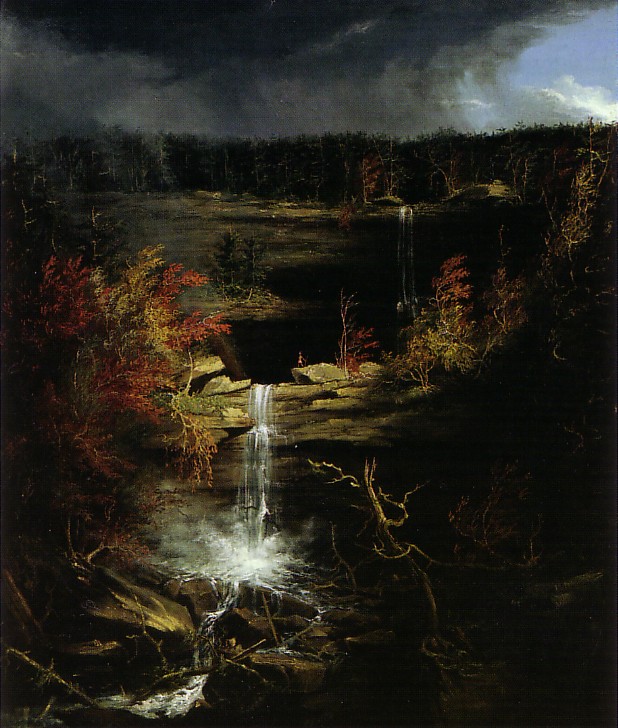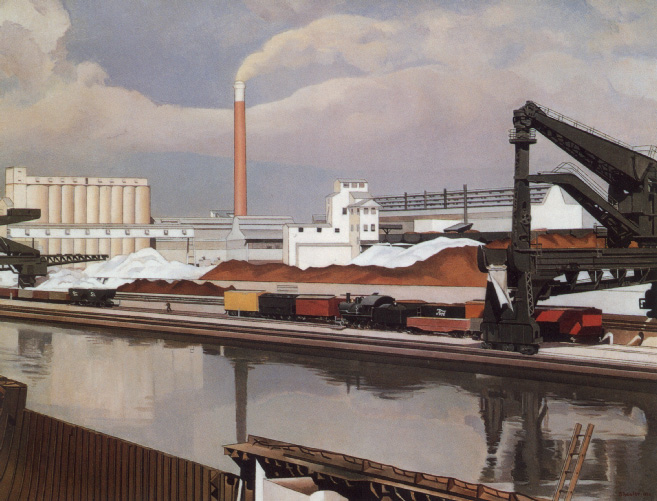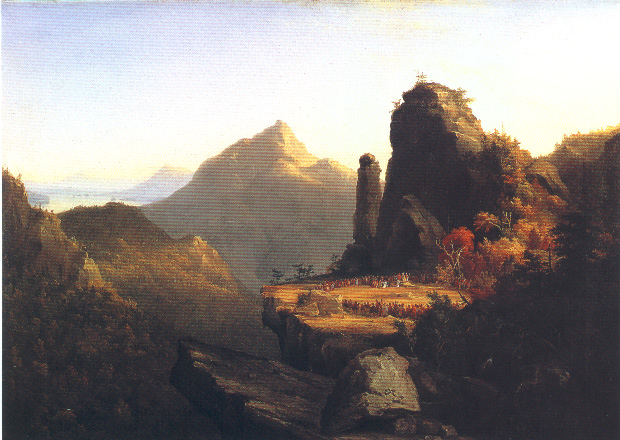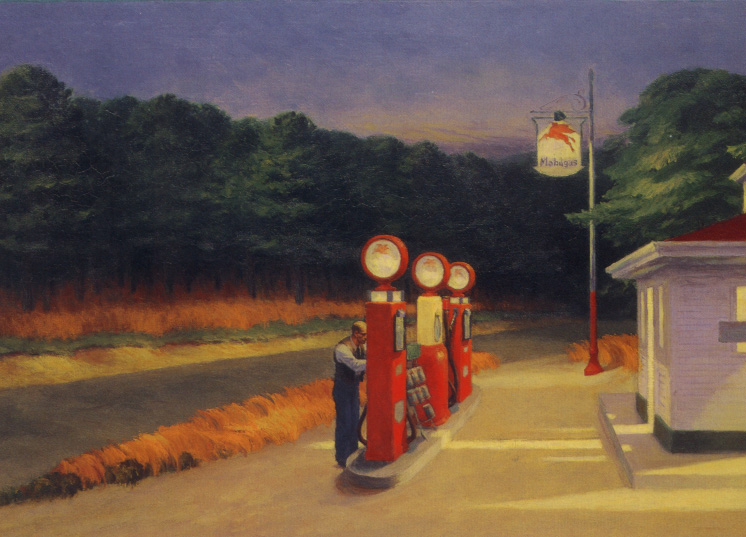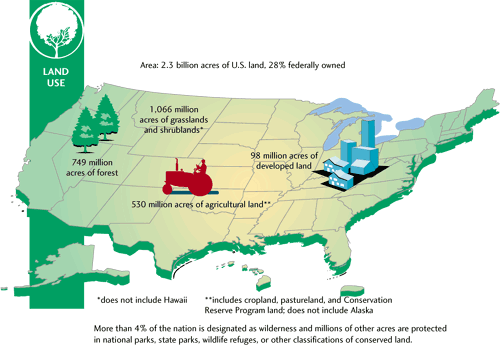 What is Art of the natural world?
What is Art of the natural world?Navigating the site:
Analysis
Title: American Environmental History in art
What is revealed by landscape art with respect to history ?
Thomas Cole, said that "To walk with Nature as a poet is the necessary condition of a perfect artist."
artists | chronology of important events | changes in scale | scenery
Smithsonian Institution artist search
![]()
Lorrain | Cole | O'Keeffe | Sheeler | Hopper | Heade
Background | Information | Essay | Argument | Conclusion | Lesson
Western Civilization and painting of landscapes.
Claude Lorrain's classical depiction of settled landscapes, 1630s.
American Civilization: national identity and painting of landsacapes.
Thomas Cole's wilder depiction of unsettled landscapes, "Kaaterskill Falls," 1826.
The western landscape inspired painters for over a century after Cole's death, as the midwest gave pioneers a home, such as Georgia O'Keeffe's family in Wisconsin.

Georgia O'keeffe, Autumn Leaves, 1915
Charles Sheeler's depiction of industrial landscapes, 1932-36.
Claude Lorraine, in France, during the seventeenth century began to make nature more than just an allegorical message in art, he focused on the transformation of the natural world
Washington Alston was among the nation's earliest artists who made nature a focus of his art
Thomas Cole, born in England and having come to New York in 1820, then studied in Europe, and returned to America where he celebrated both allegories and the wild national landscape in his paintings. His depictions of the Catskill Mountains made him and his students like Frederic Church and Asher B. Durand founding member of the Hudson River School of artists.
Thomas Cole's "The Last of the Mohicans." depicts the wild Catskill Mountains, N.Y.
Theodore Roosevelt and Gifford Pinchot were Republicans and progressives who created the national conservation movement out of a disparate set of federal agencies and bureaus in the 1900s.
Edward Hopper, Gas Station, 1940: changes the subject matter when depicting the national landscape.
Franklin Roosevelt and Harold Ickes were Progressives and later Democrats who extended conservation during the Great Depression, the Dust Bowl, and World War Two.
artists | chronology of important events | changes in scale | scenery
From 1785 until 1931 The federal government was largely promoted policies disposing of national land held in states west of the Appalachian Mountains except for Texas.
From 1878 until 1933 a counter movement grew ever more popular to curtail the disposal of national lands and instead reserve forests, retain reservoir sites, preserve wildlife, and protect watershed and waterways.
As part of the New Deal, from 1933 until 1945, several federal programs were created to conserve soil, promote flood control, save wildlife and fisheries, extend electricity to rural areas, refurbish national parks, build roads and restore historical settings.
1962-1979, Congress and the Courts passed what amounted to an environmental "bill of rights" in the public interest.
Supreme Court Justice William O. Douglas, referred to what he considered an environmental "bill of rights"
1960s, The IRS, Internal Revenue Service, ruled non-profit groups as special interests, because they lobby Congress.
2000, Congress and the Supreme Court is hostile to an environmentalist "agenda."
This Bush Administration was not supported by mainline groups:
Wilderness Society, Environmental Defense, Audubon, FOE, NRDC, World Wildlife Fund
Three NGOs (Non-governmental organizations) endorsed the opposition candidate:
League of Conservation Voters, Sierra Club, Defenders of Wildlife.
Iron Triangle, or cozy triangle of relations is an explanation of how laws are made and changed by the influence of business and labor on government agencies due to lobbyists with Congressional access who have widely influenced the legislative process.
Definitions:
reform means to bring about a desired result different from existing conditions.
Reaction means to resist reforms in order to restore previous conditions and privileges .
| liberal | conservative |
| radical | reactionary |
| strict constructionist | loose constructionist |
| judicial review | judicial activism |
| commercial improvements | laissez faire |
geographical |
special interests, trusts |
|
pragmatism and access |
| Senate | House of Representatives |
|
|
|
|
More on the orgins of conservation.
Dates:
1783 The Treaty of Paris transferred sovereignty from England's King to the United States.
1785 The Land Ordinance that established the township and range system for settling the western states
1789
The constitution went into effect creating legislative, executive, and judicial branches of government.
1828-31 federal forestry management experiment protected live oak groves, on Santa Rosa Island, Florida.
1832 George Catlin proposes a national park for wild things.
1848 The defeat of Mexico brings in California,New Mexico, Colorado, Utah, Nevada, Arizona & Wyoming areas into the Union as territories.
1849 US Department of Interior created. (USDI)
1858 Mount Vernon purchased privately as an historical site.
1862 Homestead Act passed giving away western land.
1862 US Department of Agriculture (USDA) est. to assist farm research.
1862 Morril Land Grant College Act for the study of agriculture & manufacture.
1863 National Academy of the Sciences founded to advise federal government .
1964 George Perkins Marsh published MAN & NATURE.
1864 Yosemite Valley, Ca., reserved by Lincoln as a State park.
1869 Transcontinental railroad was established.
1869 John Wesley Powell descended the Colorado River via Grand Canyon.
1871 US Fish Commission created to restore fisheries.
1872 Yellowstone national Park reserved by act of Congress in perpetuity.
1872 J. Sterling Morton designates April 10, as Arbor Day (tree planting).
1879 US Geological Survey created to inventory western lands.
1881 Division of Forestry created in USDA (1862).
1885 New York & Ontario create Niagara Reservation at the falls.
1885 New York State creates the Adirondack Forest Preserve.
1885 The origins of the Biological Survey est. in the USDA, from the old Fish Commission.
1891 The Forest Reserve Act permits Presidents to set aside public forests.
1891 California transfers Yosemite State Park to the National government.
1897 Forest Management Act defines the purpose of Forest Reserves.
1900 Lacey Act prohibits the interstate shipment of illegally killed game.
1902 Reclamation (Newlands') Act creates the Bureau of Reclamation/USDI.
1905 Transfer of the Forest Reserves from USDI to USDA.
1906 Antiquities Act creates a system of National Monuments.
1906 Pelican Island wildlife refuge among the earliest est. in the lower 48 states.
1907 Inland Waterways Commission created to improve river navigation.
1908 Grand Canyon preserved as a National Monument.
1908 Teddy Roosevelt hosts the Governor's Conference on Conservation.
1908 National Conservation Commission created by President and Congress.
1909-10 Ballinger (USDI) - Pinchot (USDA) controversy divided the Conservation movement.
1911 Weeks Act permits land purchases for forest & water protection in east.
1912 Los Angeles Water & Power Dept. takes water from the Owens Valley
1913 Hetch Hetchy Valley in Yosemite Park given to San Francisco for water.
1916 National Park Service est. for management of parks.
1918 Migratory Bird Treaty with Canada & Mexico protects nursery grounds.
1920 Federal Water Power Act passed to regulate hydropower on federal lands.
1924 Teapot Dome oil scandal in California & Utah is revealed.
1926 Restoration of Williamsburg began.
1928 Construction of Boulder (Hoover) Dam begun on the Colorado River.
1933 Civilian Conservation Corps (CCC) created to train unemployed.
1933 Soil Conservation Service (USDA) created as an emergency (dust bowl).
1933 Tennessee Valley Authority (TVA) created to revitalize 7 states.
1934 Taylor Grazing Act regulates the end of homesteading on the public land.
1940 US Fish and Wildlife Service (Wildlife Refuge System) created from the old Biological Survey.
1946 US Bureau of Land Management (BLM) established to regulate public land.
1948 Federal Water Pollution Control Act passed to regulate waste disposal.
1949 National Trust for Historic Preservation chartered by Congress.
1953 Controversy over the Hydrogen Bomb fallout brings science to the public.
1956 Echo Park Dam controversy in Dinosaur National Monument erupts.
1960 Multiple Use Act defines the purposes of the National Forests.
1963 Clean Air Act passed Congress to attack air pollution.
1964 Land & Water Conservation Fund created to buy park land and open space.
1964 Wilderness Act passed to est. a National Wilderness Preservation system.
1965
President's Science Advisory Committee's Pollution Report
1965 Lyndon Johnson hosts a White House Conference on Natural Beauty.
1966 Controversy erupts over two dams proposed in the Grand Canyon.
1966
Endangered Species Act
1968 National Wild & Scenic Rivers Act passed.
1968 National Estuarine Preservation Act passed.
1969 Santa Barbara Oil Spill blackens beaches killing sea birds & mammals.
1969 Landing on the Moon.
1969 National Environmental Policy Act (NEPA) passed to create the EPA.
1970 April 22 designated as the first Earth Day as a college teach-in.
1970 Clean Air Act reauthorization funds to stop air pollution.
1971 Congress refuses to support the supersonic transport airplane (SST).
1972
Clean Water Act
1972 Stockholm International Conference (UN) on the Human Environment.
1973 Congress authorizes the Alaskan oil pipeline crossing 800 miles.
1974 Arab Oil Embargo precipitates the "energy crisis."
1974 Freon gas (F-CFC) is predicted to endanger the protective ozone layer.
1974 Safe Drinking Water Act passed by Congress sets national standards.
1975 The use of synthetic estrogens is linked to cancer.
1975 World Population passes 4 billion.
1975 55 nuclear plants provide 7.5% of the US electricity needs.
1976 Worst west coast drought in 70 years ends (.5" of rain in s. Ca.).
1977 a 3.5 billion year old bacterial life form discovered; methanogens, transformed biology.
1977 The trans-Alaska oil pipeline costing $7.7 billion begins working.
1978 Chromosomes (previously nucleic material) found in the mitochondria, transformed biology.
1978 first successful in vitro fertilization of a human zygote.
1979 Three Mile Island, Pa. nuclear power plant damaged by an accident.
1979 Astronomers detect a "black hole" at the center of the Milky Way Galaxy.
1980 US Population exceeds 226.5 million people.
1980 State of Emergency declared in the Love Canal in Niagara Falls, N.Y.
1980 President Carter est. 40 million acres of Alaskan wildlife refuges.
1980 National Herb Garden opened in Washington, D.C.
1981 Keeping his campaign promises President Reagan dismantles conservation.
1986 Chernobyl, nuclear power plant, in Ukraine exploded causing a melted down.
1989 Collapse of the USSR (Soviet Union) and the break-up of Russia into several nations.
1990 Clean Air Act passed as a compromise est. 2010 as a compliance deadline.
1991 President Bush and Congressional Republicans seek to drill oil in refuges.
1992 United Nations Commission on Env. & Development (UNCED) holds Earth Summit in Rio.
1992 Over 100 Nations (excl. USA) sign the Biodiversity & Ozone Treaties.
1999 World population exceeds 6 billion people.
"The land, water, air and living things of the United States are a heritage of the whole nation. They need to be protected for the benefit of all Americans, both now and in the future. The continued strength and welfare of our nation depend on the quantity and quality of our resources and on the quality of the environment in which our people live."
The Environmental Pollution Panel of the Presidents Science Advisory Committee. 1965
Data:
Pressures on the land
The "land was ours before we were the lands," observed the poet Robert Frost about the national blessing we call the environment of North America. By that he meant that without having to know deeply what the country was like, colonists, pioneers and speculators had seized an entire continent. In seizing the geography of the Americas, residents of the new nation transformed the forests into lumber, the rivers into commercial avenues of trade, the lakes into o reservoirs to feed the dry lands and the burgeoning cities, and the wildlife into clothing for a fashion conscious middle class.
With utter contempt for the American masses, the nation's elites invested in mines, salt deposits, timber, canals and railroads in order to wring from the landscape the products demanded in Europe or eastern cities. Cotton farmed in the south supplied textile manufacturing in Europe and New England. Timber cut from New York, Michigan and WIsconsin forests built homes and businesses in Baltimore, Philadelphia, New York and Boston. The land yielded fortunes to the Astors, the Vanderbilts, the Rockefellers and the Pierponts, long before the Alexander Agassiz, or John Muirs or Ellen Swallow Richards rose to speak about what the territory was like, in the 1890s. Long before Mary Austin examined and described what these western terrains needed, speculators, miners, cattlemen and trappers had nearly exterminated the beavers, eradicate the bison, diverted and dammed the rivers, or deforested the slopes. We in a very big sense "did not know what we had until it was gone." In the lyrics of the Joany Mitchell song, "we paved paradise and put up a parking lot."
Population
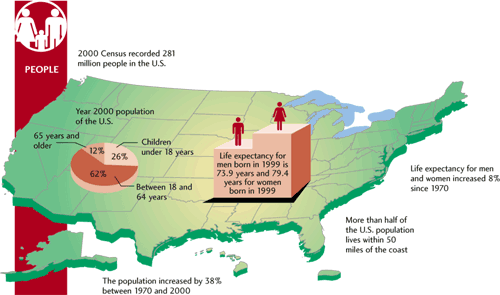
The late President Kennedy, who called a White House Conference on Conservation, in 1962, warned that the protection of the common estate from those who would despoil it is a never-ending struggle. In those terms modern democracy really requires more than an educated public, it demands a vigilant vanguard or well-informed and motivated people to inform Congress and the public about recent and ongoing scientific discoveries that can be used protect the public domain and the common property resources that we all depend upon.
High energy society
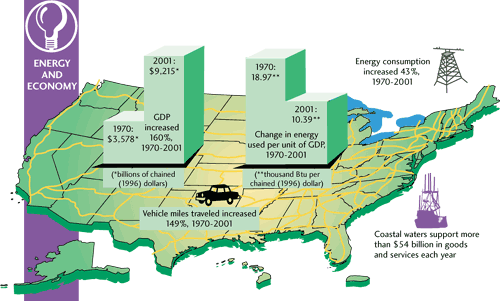
The Pew Ocean’s Commission reported last year the loss of marine fisheries to exhaustion and coastal pollution -- largely from and due to fossil fuels for energy. A series of distress signals now show that the assimilative capacity of once inexhaustible resources is exceeded and approaching exhaustion. The oceans, called a global commons, are at risk. World climate, altered by air pollution, has changed. Can further unraveling of the ecological services we depend upon be far behind? The matter is not so much will the ecological life support system fail, but how and when the losses will adversely affect human populations?
(336 words)
Wildlife, Marsh Protection, Fisheries, & Water,
Rapid changes in urban cities led to a response protecting quiet places and parks with water.
Argument
The problems we face today surpass the structural safeguards created in the 19th century to conserve natural resources for a growing population. But they are not sustained by quite as impressive a vision of the challenges facing America in the 1800s, nor does the scope and originality of that vision expressed by Bryant, Olmsted, Emerson, Thoreau, Marsh and Powell find an equal in today's pollution challenges. The vision o fthe post Civil War advocates of reform spanned the architecture of the City Beautiful Movement, the harmony of the Arts and Crafts Movement, the organized natural landscapes of Olmsted, Wright, and culminating in both national forests and national, regional and state park movements, wildlife sanctuaries, bird protection, sanitary reform and reform Darwinism.
The dust bowl of the 1930s and the pollution since the Second World War now exceed the safeguards created in the 1930s and 1960s to better manage and protect natural resources.
Paintings of landscaep, such as this by the luminists, Martin Johnson Heade and George Inness drew attention to the quiet, yet not so monumental landscapes that also portrayed American scenery as worth valueing, if not obtaining to preserve and protect it's natural features and ecological functions.
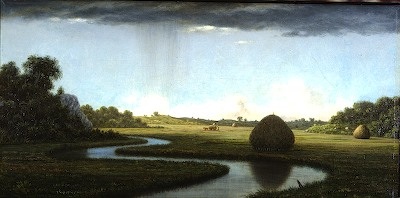
"Newburyport Marsh" dark and light on a meandering tidal creek in Mass., Martin Johnsoh Heade.
The coalition of Republicans and Democrats that emerged in 1900 and grew in power during the 1930s and 50s achieved major changes in national conservation policy. These changes in soil conservation, flood control, wildlife and fisheries protection, and land management established the basis of environmental protection in the late 1960s and 1970s.
That bipartisan coalition began to unravel in the 1980s and by the 1990s was on the defensive as the Endangered Species Act was attacked and the pollution clean-up legislation was overturned. The ideals of conservation today in protecting land, air and water resources are no longer shared by large segments of the population or Congress from 1994 until 2006.
A new image and a new vision have yet to emerge to protect the nation's natural heritage. Willofe and fisheries will be sacrificed by a further loss of habitat, due to fragmentation of essential wild areas, persistent air and water pollution, and loss of sufficiently large outdoor recreational lands.
Conclusion
Carol Browner and Christine Todd Whitman have both suggested visions and reforms based on science that are long overdue. The pressing demands on fuels, land, water and soils have only grown and the window of opportunity in addressing these matters is closing more rapidly the longer we wait.
Like compound interest on debt, the longer we wait to reduce pollution, the harder it will be and the costlier it will become to reduce ever growing perils to air and water sources. Common sense solutions exist now and can be employed with no regrets.
Lesson
Delay is not an option due to the enormity of the problem caused by rising per capita pollution and the difficulty, due to resistance, in reducing nitrogen, carbon dioxide and mercury wastes from pervasive and persistent fossil fuel combustion.
Nixon, like Kennedy and Johnson supported environmental protection.
The need for bipartisan support for resource conservation policy is a long, respected tradition.
![]()
Title | Background | Information | Essay | Argument | Conclusion | Lesson
This button below works as a navigational aid
Last Updated on january 2, 2010
By Joseph Siry
artists | chronology of important events | changes in scale | scenery
schedule | Research home | Atlas | site-map | Ecology | laws | reliable web sites | quick look
Science Index | Site Analysis | Population Index | Global Warming Index | Nature Index | Research sites | Genes
Terms | Glossary | Word webs | Basic vocabulary | Advanced Vocabulary | Antonyms | Synonyms | Etymology | Concepts
Writing | Interviews | Free Writing


